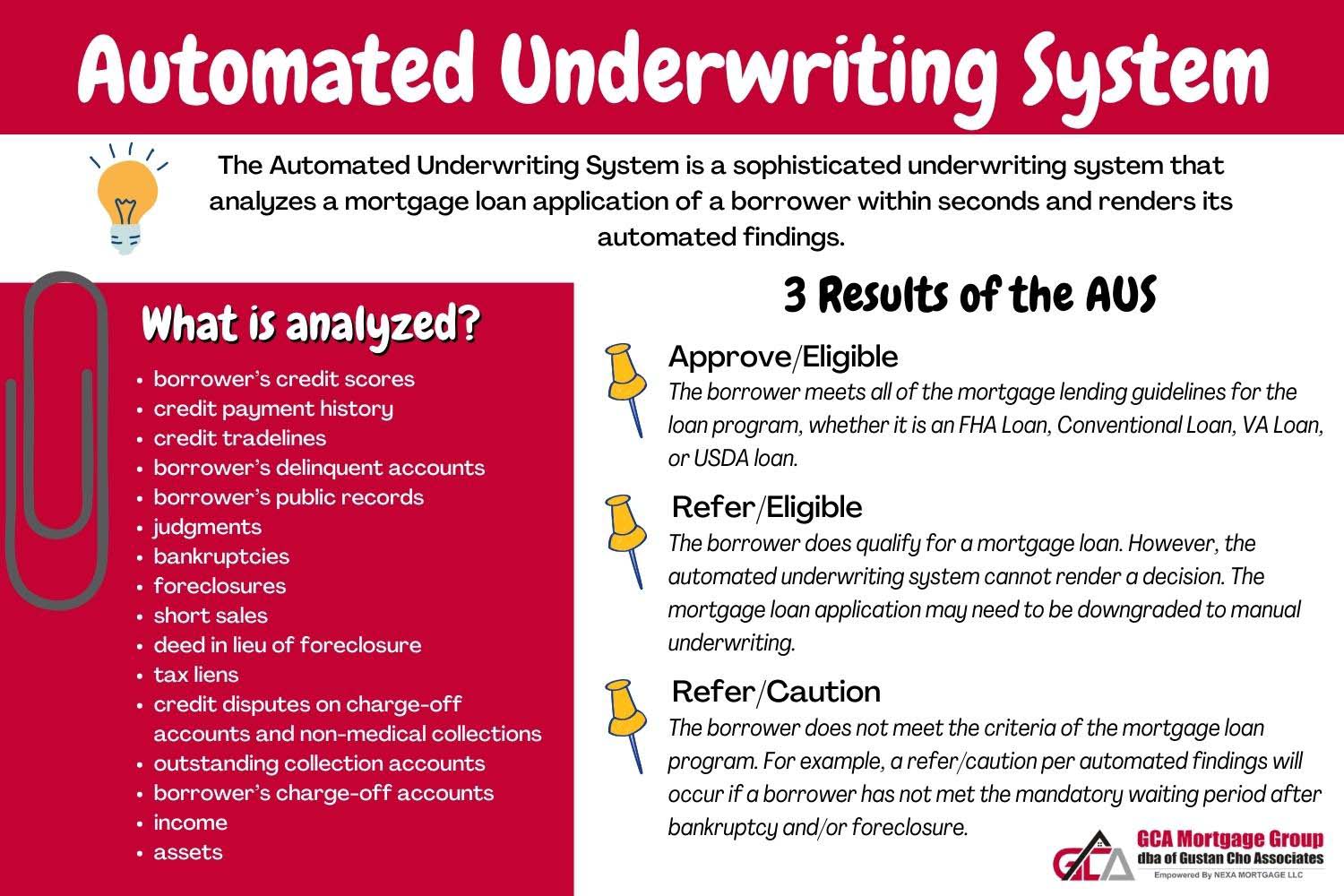What Does Refer/Eligible Per Automated Findings Means?
In this blog, we will cover and discuss what refer/eligible per automated findings means on government and conventional loans. One of the most FAQs we get at Gustan Cho Associates is What If You Get A Refer/Eligible Per Automated Findings? If you get a refer/eligible per automated findings of the automated underwriting system findings, the loan officer will keep on trying to get approve/eligible per automated findings. However, if it is next to impossible to get AUS approval, the loan officer will submit the file as manual underwriting. In the following paragraphs, we will be discussing in detail what does refer/eligible per automated findings means and how manual underwriting on VA and FHA loans work.
FHA and VA Loans Allow Manual Underwriting
FHA and VA loans are the only two loan programs that allow manual underwriting. However, manual underwriting guidelines apply. There are other times when an approve/eligible per AUS file gets downgraded to manual underwriting. This downgrade is up to the mortgage underwriter. In this article, we will discuss and cover what refer/eligible per automated findings means and how manual underwriting works.
Understanding The Automated Underwriting System
The Automated Underwriting System is a sophisticated underwriting system that analyzes a mortgage loan application of a borrower within seconds and renders its automated findings. In order for the mortgage process to proceed, the borrower needs to get approve/eligible per the automated underwriting system (AUS). However, in the event, that the borrower gets a refer/eligible per AUS, it means the AUS cannot render an automated approval but the borrower may be eligible for a mortgage via a manual underwrite.
Understanding What Manual Underwriting Means?
Manual underwriting is when a human mortgage underwriter carefully underwrites the file. FHA and VA loans are the only two mortgage programs that allow manual underwriting. Not all lenders do manual underwrites. Gustan Cho Associates is a national mortgage company licensed in multiple states with no lender overlays. A large percentage of our borrowers at Gustan Cho Associates are manual underwriting files. In this article, we will discuss and cover what refer eligible per automated findings are and how it works. Click here to Apply for VA Loans and FHA Loans
The Automated Underwriting Systems Lenders Use
The Automated Underwriting System, also known as AUS renders an automated decision after analyzing the following:
- borrower’s credit scores
- credit payment history
- credit tradelines
- borrower’s delinquent accounts
- borrower’s public records
- judgments
- bankruptcies
- foreclosures
- short sales
- deed in lieu of foreclosure
- tax liens
- credit disputes on charge-off accounts and non-medical collections
- outstanding collection accounts
- borrower’s charge-off accounts
- income
- assets
Every single line item of the borrower is stated on the 1003 mortgage loan application.
Declaration Page
All lenders require mortgage loan applicants to complete the uniform 1003 mortgage loan application. Page four of 1003 is the declaration page which asks a series of questions about the borrower. The borrower needs to answer the declaration page truthfully. The answers on the declaration page of 1003 are taken into account in the automated underwriting system findings. Analyzes the declaration page of the uniform 1003 mortgage loan application.
- where it asks whether the borrower has owned a home before
- or had a prior bankruptcy or foreclosure
- civil judgments against them
- any pending lawsuits
- Within minutes or seconds of entering the financial and credit profile into the Automated Underwriting System, the AUS will render a decision
It will come out as Approve/Eligible, Refer/Eligible, or Refer/Caution.
Approve Eligible Per Automated Findings
Approve Eligible Per Automated Underwriting System means the borrower meets all of the mortgage lending guidelines for the loan program, whether it is an FHA Loan, Conventional Loan, VA Loan, or USDA loan.
An approve/eligible per automated findings means that the Automated Underwriting System has reviewed all of the borrowers’ credit and financial profiles.
It means the AUS finds the borrower is approved via the automated underwriting system on the loan program. The approve/eligible per automated findings will come back with a list of items for the automated approval to be valid that the mortgage loan borrower needs to provide. Click here to get eligible for FHA or VA Loans
Conditions Required By The Automated Underwriting System
Examples of conditions requested by the Automated Underwriting System may be the following:
- verification of rent
- reserves
- leases on departing properties
- certain paperwork and documents
- written payment agreements
- or collection accounts or judgments to be satisfied
Mortgage lenders with no overlays will just go off the approve/eligible automated findings.
What Are Lender Overlays on Mortgage Loans?
Lenders with no overlays will not have additional lending requirements besides the conditions from the Automated Underwriting System. Homebuyers who need a direct lender who specializes in mortgage loan programs with no overlays, please contact us at Gustan Cho Associates at 800-900-8569 or text us for a faster response. Or email us at gcho@gustancho.com. Our national team of licensed and support personnel are available 7 days a week, evenings, weekends, and holidays to take your calls and answer all of your questions.
Refer Ineligible Per Automated Findings
Refer/Caution Per Automated Underwriting System means that the borrower does not qualify for the particular loan program. Ineligible means the borrower does not meet the criteria of the mortgage loan program. For example, a refer/caution per automated findings will occur if a borrower has not met the mandatory waiting period after bankruptcy and/or foreclosure.
FHA Loan After Chapter 7 Bankruptcy
FHA lending guidelines state that a borrower cannot qualify for an FHA loan after a Chapter 7 Bankruptcy unless they had passed a two-year waiting period after a Chapter 7 Bankruptcy discharge date. There is a three-year waiting period to qualify for an FHA Loan after a foreclosure, deed in lieu of foreclosure, and short sale.
Mortgage After Chapter 13 Bankruptcy
There is no waiting period after a Chapter 13 Bankruptcy discharge date to qualify for FHA and VA loans. There is a four-year waiting period to qualify for a conventional loan after a Chapter 7 Bankruptcy, deed in lieu of foreclosure, or short sale. There is a two-year waiting period to qualify for a conventional loan after a Chapter 13 Bankruptcy discharge date. There is a four-year waiting period to qualify for conforming loans after the Chapter 13 Bankruptcy dismissal date per Fannie Mae and Freddie Mac Guidelines.
Mortgage During Chapter 13 Bankruptcy Repayment Plan
Those who have recently filed for a Chapter 13 Bankruptcy can qualify for an FHA and VA loan one year into their Chapter 13 Bankruptcy with the Chapter 13 Bankruptcy Trustee’s approval. Borrowers need to show they have made timely payments to their creditors for at least 12 months.
What Is The Difference Between Refer/Eligible Per Automated Findings versus Approve/Eligible?
Refer/Eligible Per Automated Findings means that the borrower does qualify for a mortgage loan. However, the automated underwriting system cannot render a decision. The mortgage loan application may need to be downgraded to manual underwriting. Manual underwrites on FHA and VA loans are very common. All FHA and VA manual underwriting files require verification of rent.
Verification Of Rent on Manual Underwrites
Verification of Rent is only good and valid if and only if the renter can provide 12 months of canceled checks. Renters need to be timely on all rental payments for the past 12 months. Renters can also provide 12 months’ bank statements if they have been paying their monthly rental payments online via bank transfer from their account to their landlord’s bank account.
Renting From Property Management Company
If the renter has been renting their home or apartment from a registered property management company, then canceled checks are not required. Verification of rent form completed and signed by the property manager of the property management company can be used in lieu of 12 months canceled checks or 12 months bank statements. I have not heard of any lenders that do a manual underwrite on conventional loans. All manual underwriting requires timely payments for the past 12 months.
Refer/Eligible Per Automated Findings on Conventional Loans
Since manual underwriting is mainly for FHA and VA Home Loans, borrowers who get a refer eligible per automated findings on conventional mortgage loan applications, downgrading it to a manual underwrite may not be an option. However, the mortgage loan originator can play around with the Automated Underwriting System.
How Can You Get Refer/Eligible Per Automated Findings To Approve/Eligible?
Experienced loan officers can see if they can wiggle around with the data so they can get the refer eligible per automated findings to approve/eligible. The mortgage loan officer can see if they add more reserves, or put down a higher down payment if the automated underwriting system will render an approve/eligible per automated findings. If all else fails, maybe the borrower’s credit scores may need to get increased. After credit scores improve, the loan may try running it through the automated underwriting system again. Get Eligible for a mortgage loan with us, click here
Importance of Compensating Factors
Compensating factors play a crucial role in manual underwriting. These are positive financial attributes that can offset higher-risk elements in your application. Examples include:
- Cash Reserves: Having significant savings can demonstrate financial stability.
- Minimal Payment Shock: A low increase in housing payment compared to your current rent or mortgage can show you can handle the new payment.
- Long-term Employment: A stable job history indicates reliability.
- High Credit Score: Despite recent issues, a generally high credit score can be a strong positive factor.
Qualifying For A Mortgage With A Lender With No Overlays
Borrowers who need to qualify for a home mortgage with a national mortgage company licensed in multiple states with no overlays on government and conventional loans, please contact us at Gustan Cho Associates. A large percentage of our loans are manual underwrites. Over 75% of our borrowers are folks who could not qualify at other lenders due to their overlays. Contact us at Gustan Cho Associates at 800-900-8569 or text us for a faster response. Or email us at gcho@gustancho.com.
Frequently Asked Questions (FAQs)
- What does “Refer/Eligible” mean in automated underwriting findings?
“Refer/Eligible” in automated underwriting findings indicates that the loan application requires further review by a human underwriter despite meeting basic eligibility criteria. The automated system (such as DU or LP) cannot issue an immediate approval, and manual underwriting is necessary.
What causes a “Refer/Eligible” finding?
Several factors can lead to a “Refer/Eligible” finding, including:
– Insufficient credit history or non-traditional credit
– Recent late payments or derogatory credit events
– High debt-to-income (DTI) ratios
– Inconsistent or unverifiable income
– Unique property characteristics or conditions - How does a “Refer/Eligible” finding differ from an “Approve/Eligible” finding?
*Refer/Eligible: Requires manual underwriting review. The application meets basic eligibility but needs further scrutiny.
*Approve/Eligible: The automated system approves the application based on the provided information, assuming it meets all criteria without needing additional review. - What is the process after receiving a “Refer/Eligible” finding?
After receiving a “Refer/Eligible” finding, the following steps typically occur:
– Manual Underwriting: A human underwriter reviews the application in detail.
– Documentation: The borrower may need additional documentation to support their application.
– Evaluation: The underwriter evaluates compensating factors, overall creditworthiness, and the borrower’s financial situation.
– Decision: The underwriter decides whether to approve or deny the loan based on the comprehensive review. - What factors are considered during manual underwriting for a “Refer/Eligible” finding?
Manual underwriting for a “Refer/Eligible” finding considers:
* Payment history and credit patterns
* Employment stability and income verification
* Debt-to-income (DTI) ratios
* Compensating factors such as savings, large down payments, or additional assets - Can a “Refer/Eligible” finding lead to loan approval?
A “Refer/Eligible” finding can still lead to loan approval if the manual underwriter determines the borrower’s overall financial profile is strong. There are sufficient compensating factors to mitigate any identified risks. - How can borrowers improve their chances of approval after a “Refer/Eligible” finding?
Borrowers can increase their opportunity of approval by:
– Providing thorough and accurate documentation
– Reducing existing debts to lower DTI ratios
– Demonstrating stable and verifiable income
– Highlighting compensating factors such as significant savings or a strong employment history - Are “Refer/Eligible” findings common?
“Refer/Eligible” findings are relatively common, especially for borrowers with non-traditional credit profiles or recent financial challenges. They provide an opportunity for a more personalized review of the borrower’s situation. - What are compensating factors, and why are they important in a “Refer/Eligible” finding?
Compensating factors are positive financial attributes that can offset higher risk elements in a borrower’s profile. They are crucial in a “Refer/Eligible” finding as they help underwriters justify approving a loan despite potential red flags. Examples include:
* Significant cash reserves or savings
* Minimal payment shock (low increase in housing payment)
* Long-term employment history
* A high credit score despite a recent financial issue - What should borrowers expect during the manual underwriting for a “Refer/Eligible” finding?
Borrowers should expect:
– A detailed review of their financial history and documentation
– Requests for further details or explanations on specific parts of their application
– A potentially longer processing time compared to automated approvals






